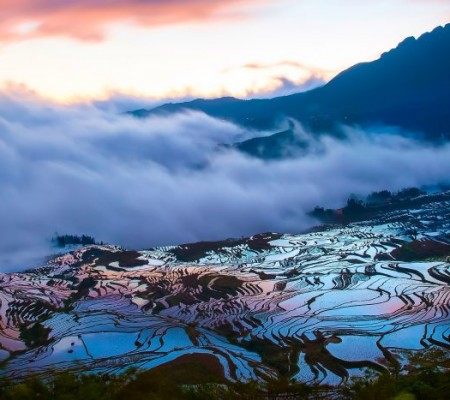
Gao Huairu – Inheritor of Folk Paintings Themed on Chinese Sages in Chenggong District, Kunming
Early Life and Interest in Folk Art
Gao Huairu (高怀汝), born in 1923, hails from Baima Road Village (白马路村), Dayu Township (大渔乡), Chenggong District (呈贡县), Kunming, Yunnan. He is a respected inheritor of the folk art of Shengxianhua (圣贤画), or paintings of Chinese sages and deities. These paintings feature a variety of revered figures, including Guanyin (观音), Guan Gong (关公), and sages from Buddhism, Taoism, and Confucianism. Traditionally, these works are hung in the central hall of a home to ensure peace, safety, and purity for the household. Before being displayed, the paintings are often “consecrated” or “opened” (开光) to ensure their effectiveness in bringing blessings.
From a young age, Gao was drawn to the folk arts of his village, particularly the Shengxianhua and Jiama Paper (甲马纸), traditional paper used in religious rituals. His curiosity and interest led him to self-study the techniques of these folk arts, dedicating himself to mastering the craft of painting sages and deities.
Mastery and Influence in Shengxianhua Painting
Through diligent study, Gao Huairu developed his own unique style of Shengxianhua. His works are known for their meticulous composition, proper balance of elements, accurate proportions, and expressive faces. His paintings portray gods and sages in a vivid and realistic manner, capturing the essence of their power and grace. Gao’s ability to adapt traditional themes while incorporating modern techniques, influenced by his background as a former elementary school teacher, has greatly contributed to the distinctiveness and popularity of his art.
His paintings are not only revered for their artistic value but also for their deep connection to local customs and traditions. Gao’s profound understanding of Jiama Paper and the local cultural heritage has made him a key figure in preserving and promoting the folk arts of Chenggong.
Legacy and Continued Influence
Gao Huairu’s works have had a lasting impact in the Chenggong region, where his Shengxianhua paintings are still widely used to decorate homes and temples. His contributions to local folk art have cemented his reputation as one of the prominent inheritors of this tradition. Gao continues to share his knowledge with younger generations, ensuring that the art of Shengxianhua and its associated customs remain alive for future generations.

 7 Days GolfingTour
7 Days GolfingTour
 8 Days Group Tour
8 Days Group Tour
 8 Days Yunnan Tour
8 Days Yunnan Tour
 7 Days Shangri La Hiking
7 Days Shangri La Hiking
 11 Days Yunnan Tour
11 Days Yunnan Tour
 6 Days Yuanyang Terraces
6 Days Yuanyang Terraces
 11 Days Yunnan Tour
11 Days Yunnan Tour
 8 Days South Yunnan
8 Days South Yunnan
 7 Days Tea Tour
7 Days Tea Tour
 8 Days Muslim Tour
8 Days Muslim Tour
 12 Days Self-Driving
12 Days Self-Driving
 4 Days Haba Climbing
4 Days Haba Climbing
 Tiger Leaping Gorge
Tiger Leaping Gorge
 Stone Forest
Stone Forest
 Yunnan-Tibet
Yunnan-Tibet
 Hani Rice Terraces
Hani Rice Terraces
 Kunming
Kunming
 Lijiang
Lijiang
 Shangri-la
Shangri-la
 Dali
Dali
 XishuangBanna
XishuangBanna
 Honghe
Honghe
 Kunming
Kunming
 Lijiang
Lijiang
 Shangri-la
Shangri-la
 Yuanyang Rice Terraces
Yuanyang Rice Terraces
 Nujiang
Nujiang
 XishuangBanna
XishuangBanna
 Spring City Golf
Spring City Golf
 Snow Mountain Golf
Snow Mountain Golf
 Stone Mountain Golf
Stone Mountain Golf




